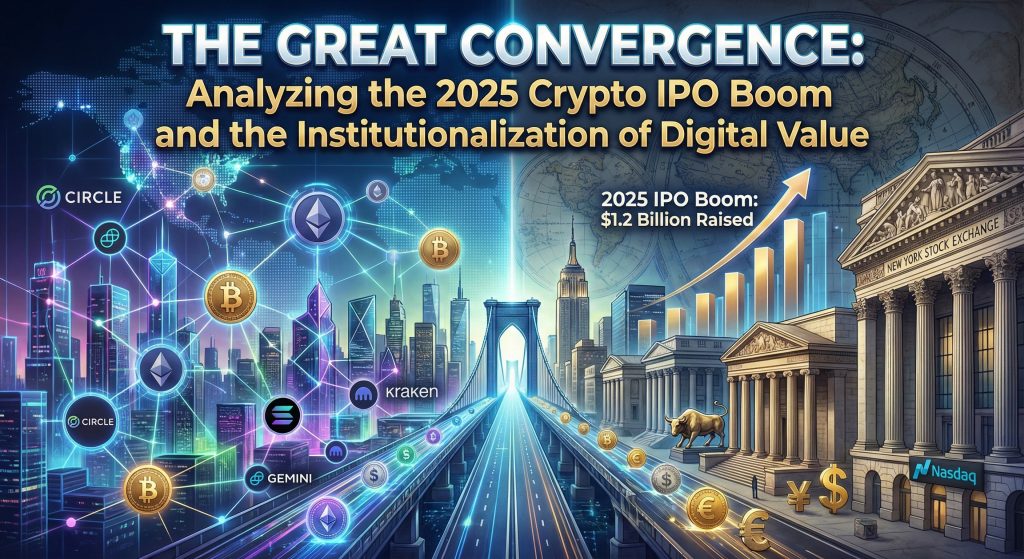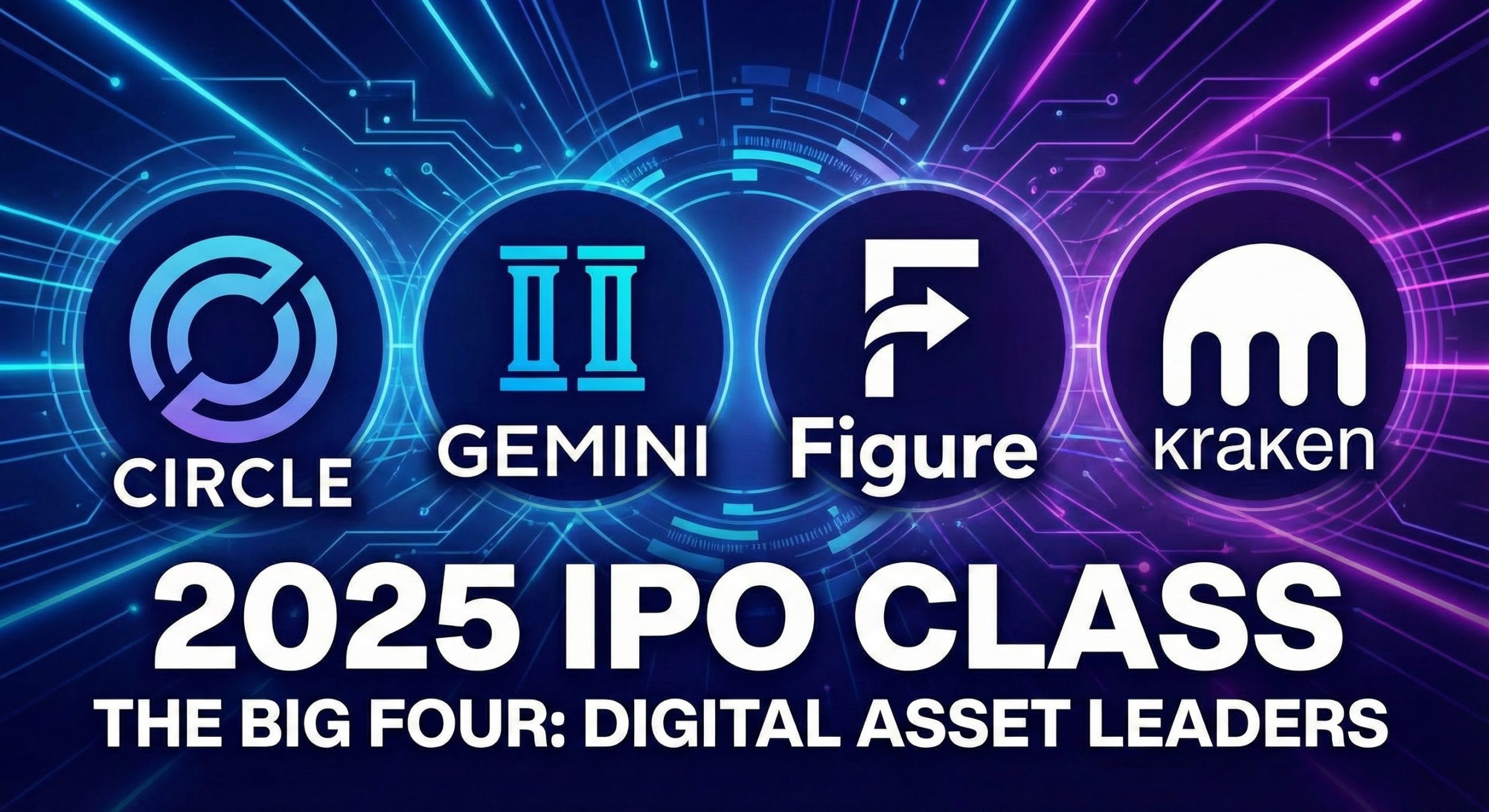2025 Crypto IPO Boom: Circle, Gemini, and the Great Convergence

The financial year of 2025 will likely be recorded by economic historians as the “Great Convergence”—the definitive moment when the cryptocurrency ecosystem ceased to be a parallel speculative economy and became an integrated vertical of the global financial system. The data is unequivocal: four major cryptocurrency companies conducted Initial Public Offerings (IPOs) in the United States, raising a combined $1.2 billion.
While this figure represents a modest 3.3% of the total funds raised in U.S. IPOs for the year, the qualitative impact of these listings far exceeds their quantitative footprint. The arrival of these firms on the New York Stock Exchange (NYSE) and Nasdaq signals a transition from the “Wild West” era of digital assets to a period of regulatory integration, standardized financial reporting, and deep institutional capital deployment.
This report provides an exhaustive analysis of this pivotal year, examining the “Big Four” IPOs—Circle, Gemini, Figure Technologies, and the looming arrival of Kraken—and what this means for the future of crypto ecommerce platforms and global finance.
1. Executive Summary: Key Performance Indicators (2025)
The maturation of the sector is evidenced by the explosion of regulated investment vehicles. The number of global cryptocurrency Exchange-Traded Products (ETPs) surged to 367 in 2025, up from just 104 in 2021, managing over $222 billion in assets. This expansion signals a regulatory capitulation to market demand and a massive shift in how institutional capital accesses digital assets.
| Metric | Value | YoY Change / Context |
|---|---|---|
| Total Crypto Market Cap | $3.2 – $3.5 Trillion | Surpassed 2021 Peak |
| Global Crypto ETPs | 367 | +252% since 2021 |
| Crypto ETP AUM | $222.3 Billion | Significant Institutional Hold |
| US Crypto IPO Fundraising | $1.2 Billion | 3.3% of Total US IPO Market |
| Bitcoin Dominance | ~62% | Up from 38% in Jan 2023 |
| Stablecoin Market Cap | >$200 Billion | Dominated by Tether & Circle |
2. Macroeconomic Context: The “Trump Trade” and Monetary Shifts
To understand the 2025 IPO boom, one must first dissect the macroeconomic and political soil in which these listings took root. The resurgence of the crypto market was deeply correlated with a broader risk-on sentiment fueled by specific political outcomes in the United States.
The Political Tailwind and Regulatory Thaw
The return of the Trump administration acted as a potent catalyst. Unlike the regulatory hostility of previous years, 2025 saw a pivot toward accommodation. This encouraged wider acceptance among traditional financial institutions (TradFi) and led to the appointment of regulators who favored “generic listing standards.” This shift effectively cleared the runway for assets like Solana to gain ETF status without the legal battles that defined the Bitcoin ETF journey.
In a historic move, the U.S. Department of Commerce published key economic statistics, specifically GDP data, on public blockchain platforms. This act served as a powerful signal to capital markets: the technology is no longer a pariah; it is a tool of the state.
Interest Rates and the “Pure Play” Scarcity
Following inflationary pressures, 2025 saw a stabilization that allowed capital markets to reopen. The Federal Reserve initiated rate cuts that reduced the cost of capital, encouraging a rotation back into growth equities. Prior to 2025, investors were largely limited to Coinbase or proxy plays like MicroStrategy. The 2025 IPO wave corrected this “Coinbase Premium” by supplying institutional investors with diverse instrumentalities—from stablecoin yields to real-world asset lending.
3. The IPO Class of 2025: Deep Dive Analysis
The core of this shift lies in the four entities that defined the 2025 public listing cycle. Each represents a distinct sub-sector of the crypto economy: Payments, Exchange/Custody, Real World Assets, and Institutional Infrastructure.

3.1 Circle Internet Group (NYSE: CRCL): The Digitization of the Dollar
The IPO of Circle Internet Group was arguably the most significant fintech listing of the decade. As the issuer of USD Coin (USDC), Circle operates the plumbing for a digital dollar economy. Its successful listing marked the moment stablecoins became a recognized component of the U.S. monetary supply chain.
Circle priced its IPO at $31 per share, raising approximately $1.1 billion. Upon debuting on the NYSE, the stock surged 168% on the first day. This “pop” was driven by the scarcity of regulated quality assets and the passing of stablecoin legislation that legitimized the business model. For merchants, this validates the reliability of using a USDC-ERC20 payment gateway for global settlement.
Strategic Insight: Circle’s success validates the “stablecoin-as-a-service” model. It is no longer just a crypto company but a monetary logistics company, competing with the SWIFT network.
3.2 Gemini Space Station (NASDAQ: GEMI): The Compliance Premium Tested
If Circle was the triumph, Gemini was the complex middle child. Listing on the Nasdaq in September 2025, Gemini priced its shares at $28, raising $425 million. However, the stock faced headwinds, retreating to the $10-$12 range by November.
While Gemini has long positioned itself as the “security-first” exchange, analysts pointed to a lack of volume compared to competitors. However, a strategic stake from Nasdaq Inc. suggests Gemini’s future may lie in white-label infrastructure for traditional finance rather than retail trading.
3.3 Figure Technologies (NASDAQ: FIGR): The Real World Asset (RWA) Pioneer
Figure Technologies represents the “utility” phase of crypto. Listing on Nasdaq in September, Figure raised $787.5 million. Unlike exchanges, Figure uses blockchain to originate and securitize home equity lines of credit (HELOCs), reducing loan origination times from 42 days to just 10 days.
Investors rewarded Figure for decoupling from crypto price volatility. Its success suggests that the next wave of crypto equities will be fintechs using blockchain rails to displace legacy back-office intermediaries.
3.4 Kraken: The Whale Surfaces
While others listed, Kraken spent 2025 preparing for a massive 2026 debut. Filing confidentially in November 2025 after an $800 million pre-IPO raise, Kraken is the only true competitor to Coinbase in terms of depth and tenure. With significant profitability and a strategy to become a comprehensive prime broker, Kraken represents a “value” play for the coming year.
4. The ETP Explosion: 367 Ways to Invest
The public equity markets were matched in intensity by the Exchange-Traded Product (ETP) sector. The expansion to 367 global crypto ETPs represents the granularization of access.
- The Solana Breakout: A defining narrative was the regulatory breakthrough for Solana. Following the SEC’s adoption of “generic listing standards,” Bitwise launched a Solana Staking ETF that attracted $420 million in its first week.
- LSEG Pivot: The London Stock Exchange reversed policy to allow retail crypto ETNs, positioning London as a renewed competitor to New York.
- Global Divergence: Hong Kong continued to aggressively list spot ETFs, positioning itself as the crypto hub for Asian liquidity.
This explosion in ETPs mirrors the growing demand for direct crypto payments. Just as investors want easy access via ETFs, consumers increasingly demand the ability to pay via ETH payment gateways and other direct chain methods.
5. Market Structure and Future Projections
The narrative of “separation” between crypto and state has effectively died; the new narrative is “integration.” Banks are entering via custody, and the “regulation by enforcement” era has shifted to “regulation by structure.”
The M&A Supercycle and Tokenization
With Circle and Figure now armed with public currency, 2026 will likely see a wave of M&A. Regulated entities will acquire DeFi protocols to integrate vertical stacks. Furthermore, Figure’s success proves the RWA thesis. We expect future IPOs to focus on tokenizing treasuries and private credit. The line between a “crypto company” and a “fintech” will blur until it is invisible.
6. Ricky’s Perspective
The “Infrastructure” vs. “Casino” Divergence
The market has spoken clearly: it values utility over speculation in the current high-rate environment. Circle’s massive success versus Gemini’s struggle underscores this. Circle is infrastructure; it is the rails upon which money moves. The smart money is chasing the plumbing—stablecoins and lending rails. This is why businesses should focus on robust integrations rather than speculative trends.
The Solvency of SOL
The approval of the Solana ETF is arguably more significant than the Bitcoin ETF. By allowing Solana ETFs, regulators have implicitly accepted that “programmable value” is an investable asset class. This opens the floodgates for further innovation in the crypto invoicing and smart contract space.
Final Verdict
We are witnessing the “adulting” of crypto. It is boring compared to the ICO mania of 2017, but “boring” is what attracts trillions in pension fund capital. The 3.3% of IPO fundraising is just the beachhead. The revolution is no longer televised; it is being listed on the Nasdaq.
7. Appendix: Comparative Analysis of 2025 Crypto IPOs
| Company | Ticker | Sector | Raised | Performance Trend |
|---|---|---|---|---|
| Circle | CRCL | Stablecoin/Payments | $1.1B | Strong Bullish (High demand for regulated stablecoin exposure) |
| Figure | FIGR | Fintech/Lending/RWA | $787M | Bullish (Profitable, clear utility model) |
| Gemini | GEMI | Exchange/Custody | $425M | Bearish/Neutral (Struggling against volume leaders) |
| Kraken | N/A | Exchange/Futures | N/A | Pending (High anticipation due to revenue scale) |
For more insights on how these institutional shifts affect merchant payments and global settlements, explore our API documentation to stay ahead of the curve.

